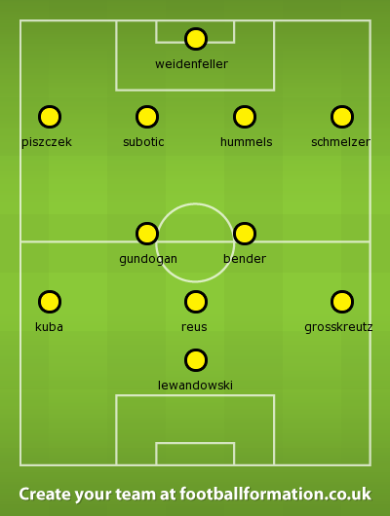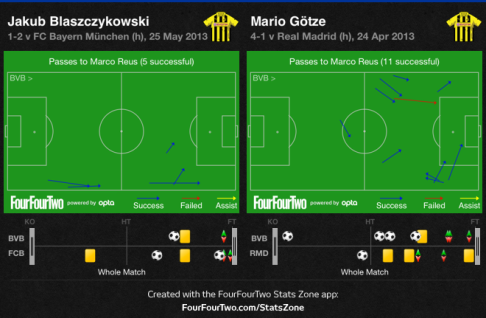Bayern Munich claimed their fifth Champions League title courtesy of an Arjen Robben winner in the 88thminute.
There were no real surprises in either starting line up as both sides stuck with their traditional 4-2-3-1. Mario Mandzukic led the line, while Thomas Muller, Franck Ribery and Arjen Robben played behind the Croatian striker. Javi Martinez and Bastian Schweinsteiger played in midfield, while Jerome Boateng was selected over Daniel van Buyten to start at centre back.
Jurgen Klopp selected his best side possible – Marco Reus, Jakub Błaszczykowski and Kevin Großkreutz played behind Robert Lewandowski. Ilkay Gündoğan and Sven Bender formed a midfield two, and Mario Gotze was forced to watch the game in the stands as he failed to recover from an injury.
Ultimately, it was a game of two halves – Dortmund’s pressing nullified Bayern in the first, but as they tired Bayern imposed their authority on the match.
Pressing
As Juventus did for a short period of time when they met Bayern in the quarter-final stage, Dortmund pressed Bayern high up the pitch. Lewandowski and Reus prevented Boateng and Dante from pushing forward, while Großkreutz and Błaszczykowski had the same effect on Bayern’s fullbacks. Bayern struggled to play from the back, so Schweinsteiger dropped in between the two Bayern centre backs to provide them with a passing option. This created 3v2 situations, but Schweinsteiger had no passing options available – Dortmund’s fullbacks stayed tight to Bayern’s wingers, Martinez was picked up and Muller didn’t drop into midfield.
Toni Kroos has dominated this fixture this season, as the German playmaker had the tactical awareness to drop into the midfield to give Schweinsteiger and the Bayern centre backs an extra passing option. Muller on the other hand was looking to receive the ball in between the lines – Bayern struggled to get on the ball into Dortmund’s half, as they failed to play forward passes.
Bayern dropped into two banks of four when Dortmund aimed to play from the back. Muller and Mandzukic closed down Neven Subotic and Mats Hummels preventing them from coming forward to play key passes. Gündoğan had little to no impact on the match – Heynckes’ men did an excellent job in shutting down the Dortmund maestro, as he failed to play positive forward passes. Martinez and Schweinsteiger took turns closing him down in midfield, while Mandzukic pressed the German midfield when he dropped deeper.
Dortmund counter
Dortmund’s pressing was beneficial from both an offensive and defensive standpoint – they prevented Bayern from gaining a rhythm, and it allowed them to win the ball higher up the pitch in order to work quick transitions. Reus was the focal point of their attack, and he caused Bayern’s back line a few problems when he had the ball.
Considering Gündoğan was marked out of the match, Reus provided the link between midfield and attack. The German attacker dropped deep into the midfield to pick up the ball, and he ran at the Bayern defence. Reus combined well with Lewandowski, but rarely did you see him connect with the Dortmund wingers.
Gotze and Reus have developed a strong partnership this season, that sees them play quick intricate passes amongst one another – we didn’t see much of that against Bayern.
Although Dortmund was thriving with their quick transitions, they failed to take any of the chances they created. Dortmund had six shots in the opening 25 minutes before Bayern recorded their first shot, but Klopp’s men failed to beat Manuel Neuer when they had control of the match.
Robben’s chances
One can argue that it was meant to be for Arjen Robben. The Dutch winger made appearances off the bench for majority of the season, but was thrown into the starting lineup when Toni Kroos limped off the field against Juventus in the quarter-finals. Since then Robben has produced some fantastic displays, reminding many that on his day he’s one of the best wingers in football.
In the past Robben hasn’t taken advantage of opportunities handed to him in monumental matches, and it looked like this familiar theme would continue based on his first half outing. All three chances occurred in the final 15 minutes of the half, when Bayern gained control of the match.
Roman Weidenfeller made a good save to deny Robben on his initial chance, as the Bayern winger ran behind Marcel Schmelzer, who was tucked in due to Dortmund’s narrow shape. Muller’s pass found Robben, but he was unable to beat the Dortmund goalkeeper.
Robben and Muller combined well on the right for his second chance – Robben passed the ball to Muller, he then drifted centrally and ran behind Subotic. Muller played a delightful ball to the Bayern winger, but he was unable to create a chance or beat Weidenfeller.
Dante’s hopeful long ball created Robben’s final chance as Hummels failed to deal with the ball in the air. Robben pounced on Hummels’ error, but the Dutch winger’s shot bounced off Weidenfeller’s face.
Robben was Bayern’s danger man going forward, looking to exploit the space behind Dortmund’s back line, but the Dutch winger’s finishing let him down severely.
Bayern/Schweinsteiger grow into the match
There were two key changes in the second half – Robben and Muller swapped positions, while Dortmund’s energetic pressing eventually faded.
Dortmund was unable to sustain there pressing for the entirety of the match, while Bayern worked harder as a unit to close down Dortmund. Klopp’s men tired, and this allowed Schweinsteiger to take over the match. He began to play positive passes around the pitch, and Bayern began to demonstrate their superiority in midfield.
Schweinsteiger controlling the tempo of the match was a problem Dortmund faced, but surprisingly it was far from their major concern. Klopp’s men slowly stopped pressing, but they still kept a high-line. So now, not only was there more space for Schweinsteiger to dictate, but there was also heaps of space for Muller and Robben to attack.
Bayern created more chances in the second half, which ultimately led to goals.
Robben moves centrally
I must highlight that Robben also completed his defensive duties exceptionally well, as did Ribery – throughout the tournament both men have prevented overloads and kept opposing fullbacks from having an impact on matches.
The half-time change allowed Robben to have a larger influence on the match going forward. The Dutch winger who was already drifting centrally throughout the first half, began to make diagonal runs behind the Dortmund defence or into the channels.
Bayern’s goal started with Mandzukic chesting the ball to Robben. The Dutch striker played a pass to Ribery, made a run behind Subotic and Bender, and received a pass from the French winger, which allowed him to square the ball to Mandzukic. Robben’s second chance in the first half was similar – the only difference was Robben combined with Muller and he completed the pass to Mandzukic.
Robben nearly gave Bayern the lead, as Muller’s powerful run allowed him to latch onto a loose ball and round Weidenfeller, but Subotic cleared his pass that was squared for Robben.
The Dutch winger became provider, as he played a lovely through ball for Muller in a deeper position, but the German attacker was unable to get his shot off. Robben was Bayern’s key man going forward, and it was fitting that he got the winner with minutes to go.
Ribery held up David Alaba’s simple longball from a free kick, and back heeled it to Robben, who made a surging run from midfield – Robben skipped past challenges from Subotic and Hummels and slid the ball past Weidenfeller. Dortmund didn’t comfortably deal with Dante’s long ball in the first half, and Weidenfeller made a fortunate save to deny Robben – this time Robben kept his composure and haunted Dortmund for making the same mistake.
Conclusion
The third time was a charm for Bayern, as Heynckes’ men avenge their heartbreaking loss against Chelsea last season. Ironically they win the title in London, after losing 12 months ago to a London side at home.
Throughout this tournament, they’ve adapted to their opponents style of play, displaying their tactical flexibility and ability to cope without Kroos. Like he did at Madrid, Heynckes leaves Bayern a European champion – he’s created a side that was undoubtedly the best in Europe this season, and they’ll only get stronger under Guardiola’s wing.
Bayern improved in the second half as Dortmund tired – but Klopp’s men failing to take their chances, stem away from their high line, as well as coping with Robben was the difference maker on the night. For the second time this season in a cup competition, the Dutch winger haunts Dortmund with a moment of brilliance keeping the Bavarians on course for an historic double.











Comments are closed.